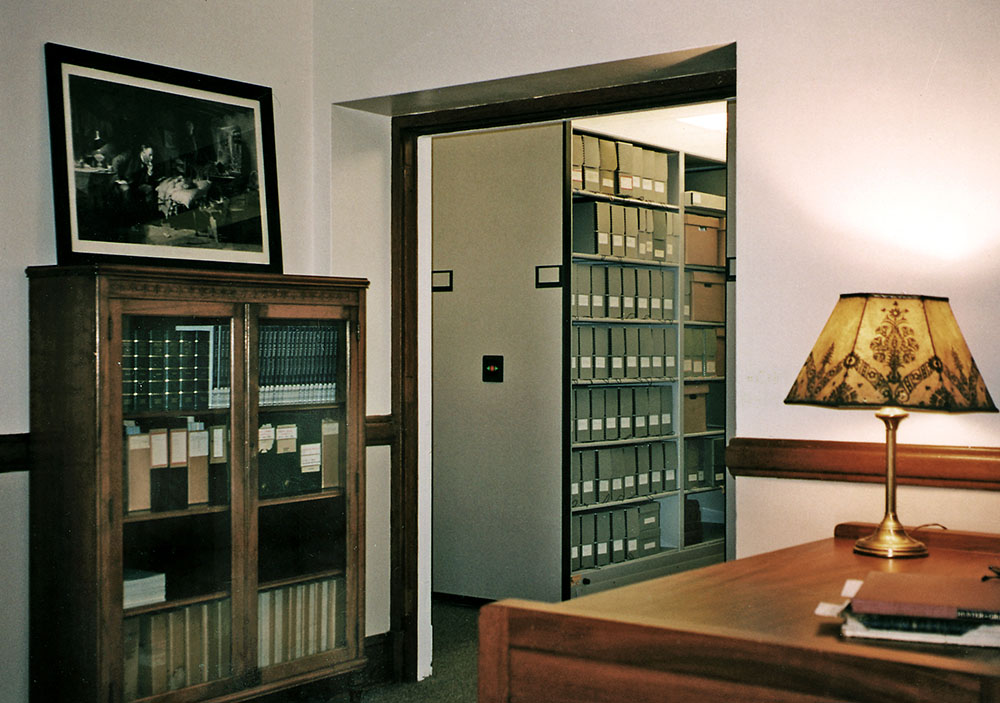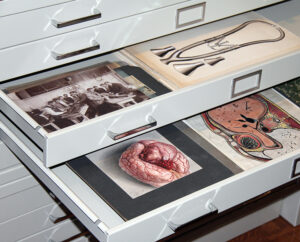
View of Dittrick Medical History Center Archives. Dittrick Medical History Center, Case Western Reserve University.
Archival Spotlights: Post #2
The Society of Ohio Archivists Advocacy and Outreach Committee (A&O) wanted to celebrate Archives Month in a new way, so we are featuring a handful of archives in a series of posts we are calling Archival Spotlights. Since the Archives Month poster’s theme was “Ohio’s Healthcare Workers: The True Heart of it All,” we felt it a good idea to feature archives that focus on healthcare or have interesting collections related to healthcare.
About the Dittrick Medical History Center and its Collections
By A&O Committee Member Amy Czubak, Ohio History Connection.
Have you ever wanted to read a letter written by Charles Darwin? Examine intricately detailed medical drawings? Maybe see inside of a Civil War era amputation kit? The Dittrick Medical History Center at Case Western Reserve University in Cleveland, Ohio, has all of these things and more! Named after the first curator, Dr. Howard Dittrick (1877–1954), the museum and archives has been collecting medical history for nearly 100 years and has the most comprehensive collection concerning medical instruments and implements in the United States.

Diagrams found in the Dittrick Medical History Center Archives include this one of a disk oxygenator. The disk oxygenator removes carbon and gasses from the blood and adds in oxygen.
Disk oxygenator diagram engineered by Richard Jones, PhD. Dittrick Medical History Center, Case Western Reserve University.
The Cleveland Medical Library Association, established in 1894, developed a historical committee in 1898. At its helm was a prominent Cleveland area surgeon named Dr. Dudley Peter Allen (1852–1915), who was tasked with caring for and preserving donations given to the Cleveland Medical Library Association by Dr. Allen and other members of the Association. A new medical library built on land donated by Western Reserve University, and funded by money donated by Dr. Allen’s widow, was established in 1926 and featured a third floor museum gallery.
First called the “Museum of Historical and Cultural Medicine,” the museum hired Dr. Howard Dittrick to be their first curator in 1926, the same year the building was completed. According to the history section of their website, Dr. Dittrick “amassed a large collection of medical instruments ranging from Roman implements to ‘pioneer’ physician saddlebags.” Hospitals and physicians have continued to donate medical and health-related items to the institution for nearly 100 years, making the Dittrick Museum the repository for “one of the most comprehensive medical artifact collections in the US.”

This photograph from the archives shows the disk oxygenator being used by Dr. Earle B. Kaye.
Dittrick Medical History Center, Case Western Reserve University.
The Museum changed their name in 1998 to the Dittrick Medical History Center. They not only have medical instruments, but also a variety of archival papers including: physician’s papers; letters written by Charles Darwin; collections from medical institutions such as the Medical Institutions of Cleveland and other hospitals; and collections from medical professional societies such as American College of Gastroenterology.

A peek inside an archival storage cabinet showing the incredibly detailed medical illustrations created by H.F. Aitken.
Dittrick Medical History Center, Case Western Reserve University.
Alongside photographs and manuscript collections, the Dittrick Medical History Center Archives also has a wonderfully vivid collection of medical illustrations. According to the Aitken Illustrations page, “Aitken worked with leading figures of American surgery and anatomy, including Harvey Cushing, Frank H. Lahey, and John Collins Warren, II, as well as the leading medical illustrator Max Brödel at Johns Hopkins University.” His collection contains over 2,000 sketches, drawings, paintings, and more.
Interview with Jennifer Nieves
Jennifer K. Nieves is the Archivist/Museum Registrar for the Dittrick Museum History Center. She was kind enough to answer a couple of questions about her job and collections for the Advocacy and Outreach Committee.
A&O: What is your most favorite collection in your archive? Why?
Jennifer: My favorite collection is that of the Lakeside Unit of World War I. While cataloging a collection of glass slides I began to see familiar faces, in an unfamiliar situation. After some research, I discovered these to be images of the Lakeside Unit, a medical unit of surgeons and nurses from Cleveland’s Lakeside Hospital, many of whom I recognized from cataloging their individual collections and photographs. Under the direction of Cleveland Clinic founder George W. Crile, MD, the Unit served three months at the American Ambulance in Paris in 1915 treating wounded French and British soldiers.
Upon their return to Cleveland, Crile prepared a plan to make US civilian hospitals available for overseas military service, marking the beginning of what became known as the Hospital Unit Plan of Organization. I also found diaries, case books and photographs from documenting the Unit’s service. I pulled these collections together (virtually, not physically) and created what we now call the Lakeside Unit Collection. Until I started working on this collection I had very little knowledge of World War I history, much less the history of medical advancements during that period. My research using this collection has led to numerous presentations, exhibits, a book chapter, and a website.
A&O: What do you like most about working at the Dittrick Medical History Center?
Jennifer: I’ve been at the Dittrick Museum since 1989. Over the years I have worked with a very knowledgeable staff and an amazing collection, enabling me to soak in the history of medicine. The best part of working with a research collection like this is that it was designed to be comprehensive. If I’m reading an article about a groundbreaking medical instrument in 1935, I’m pretty sure I will find it in our collection. Lots of exciting discoveries!
Learn more about the Dittrick Medical History Center at https://artsci.case.edu/dittrick/.
All images courtesy of Jennifer Nieves, Archivist/Museum Registrar, Dittrick Medical History Center, Case Western Reserve University.
Questions? Contact A&O Committee Chair Collette McDonough.
Last Updated on October 25, 2022 by janet_carleton
